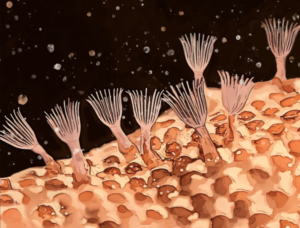Ocean acidification and coral bleaching are two serious problems for coral reefs, both linked to climate change but impacting corals in different ways.
Ocean Acidification
Ocean acidification happens when there’s too much carbon dioxide (CO₂) in the atmosphere, mostly from human activities like burning fossil fuels. About one-third of this CO₂ is absorbed by the oceans, which causes chemical reactions that lower the pH of seawater, making it more acidic. This reduces the availability of carbonate ions, which are crucial for marine organisms like corals to build their skeletons. With less carbonate, coral skeletons become thinner and weaker, making them more likely to break. According to a study by the Woods Hole Oceanographic Institution, ocean acidification stops coral skeletons from thickening properly, leaving them fragile and vulnerable. (Woods Hole Oceanographic Institution)
Coral Bleaching
Coral bleaching happens when environmental changes, like warmer sea temperatures, stress the corals. This stress causes them to expel the algae (called zooxanthellae) that live in their tissues and provide them with food and color. Without these algae, the corals turn white, or “bleach,” and if they remain stressed, they may eventually die. NOAA (National Oceanic and Atmospheric Administration) points out that while some corals can survive bleaching, they’re left weak and are more likely to die if conditions don’t improve. (NOAA Ocean Service)
Combined Impact
When ocean acidification and coral bleaching occur together, the effects are even worse. Acidified waters make coral skeletons weaker, so they’re less likely to recover from bleaching events. Additionally, acidification makes it harder for corals to rebuild their skeletons after a bleaching event by reducing the amount of calcium carbonate available. The Union of Concerned Scientists explains that corals have a harder time recovering from bleaching because they can’t access enough of the materials they need to regrow. (Union of Concerned Scientists)
What Can Be Done
To protect coral reefs, we need global action to lower CO₂ emissions, which would help reduce both ocean acidification and the frequency of coral bleaching. Local conservation efforts, like creating marine protected areas and cutting down on pollution, can also make reefs stronger. The Earth Journalism Network highlights that cutting emissions would have positive effects both on land and in the ocean. (Earth Journalism Network)
In Summary
While ocean acidification and coral bleaching are different processes, they work together to harm coral reefs. If we want to protect these vital ecosystems, it’s important to understand both issues and work towards solutions that address them.
Work Cited
Woods Hole Oceanographic Institution. “Scientists Identify How Ocean Acidification Weakens Coral Skeletons.” WHOI, https://www.whoi.edu/press-room/news-release/scientists-identify-how-ocean-acidification-weakens-coral-skeletons/.
National Oceanic and Atmospheric Administration. “What is Coral Bleaching?” NOAA, https://oceanservice.noaa.gov/facts/coral_bleach.html.
Union of Concerned Scientists. “CO2 and Ocean Acidification.” Union of Concerned Scientists, https://www.ucsusa.org/resources/co2-and-ocean-acidification.
Earth Journalism Network. “Ocean Acidification and Coral Bleaching.” Earth Journalism Network, https://earthjournalism.net/resources/ocean-acidification-and-coral-bleaching.
The views and opinions expressed are those of the authors and do not necessarily reflect nor represent the Earth Chronicles and its editorial board.




